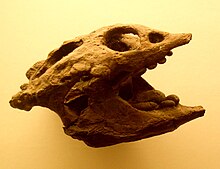Placodontia
| Placodonts Temporal range: Triassic
| |
|---|---|

| |
| Placodus, type genus | |
| Scientific classification | |
| Domain: | Eukaryota |
| Kingdom: | Animalia |
| Phylum: | Chordata |
| Class: | Reptilia |
| Superorder: | †Sauropterygia |
| Clade: | †Placodontiformes |
| Order: | †Placodontia Cope, 1871 |
| Families | |
|
Cyamodontidae | |
Placodonts ("Tablet teeth") were a group of marine reptiles that lived during the Triassic period, becoming extinct at the end of the period. It is believed that they were part of Sauropterygia, the group that includes plesiosaurs. Placodonts were generally between 1 to 2 m (3.3 to 6.6 ft) in length, with some of the largest measuring 3 m (9.8 ft) long.
The first specimen was discovered in 1830. They have been found throughout central Europe, North Africa, the Middle East and China.
Palaeobiology

The earliest forms, like Placodus, which lived in the early to middle Triassic, resembled barrel-bodied lizards superficially similar to the marine iguana of today, but larger. In contrast to the marine iguana, which feeds on algae, the placodonts ate molluscs and so their teeth were flat and tough to crush their shells. In the earliest periods, their size was probably enough to keep away the top sea predators of the time: the sharks.[citation needed] However, as time passed, other kinds of carnivorous reptiles began to colonize the seas, such as ichthyosaurs and nothosaurs, and later placodonts developed bony plates on their backs to protect their bodies while feeding. By the Late Triassic, these plates had grown so much that placodonts of the time, such as Henodus and Placochelys, resembled the sea turtles of modern day more than their ancestors without bony plates. Other placodonts, like Psephoderma, developed plates as well, but in a different articulated manner that resembled the shells of horseshoe crabs and trilobites more than those of sea turtles. All these adaptations can be counted as perfect examples of convergent evolution, as placodonts were not related to any of these animals.
Because of their dense bone and heavy armour plating, these creatures would have been too heavy to float in the ocean and would have used a lot of energy to reach the water surface. For this reason, and because of the type of sediment found accompanying their fossils, it is suggested that they lived in shallow waters and not in deep oceans.
Their diet consisted of marine bivalves, brachiopods, and other invertebrates. They were notable for their large, flat, often protruding teeth, which they used to crush the molluscs and brachiopods that they hunted on the sea bed (another way in which they were similar to walruses). The palate teeth were adapted for this durophagous diet, being extremely thick and large enough to crush thick shell. Henodus, however, developed unique baleen-like denticles, which alongside features of the hyoid and jaw musculature suggest that it was a filter feeder.[1][2]



Classification
- Class Reptilia
- Superorder Sauropterygia
- Order Placodontia
- Superfamily Placodontoidea
- Family Paraplacodontidae
- Genus Paraplacodus
- Family Placodontidae
- Genus Placodus
- Family Paraplacodontidae
- Superfamily Cyamodontoidea
- Family Henodontidae
- Genus Henodus
- Family Cyamodontidae
- Genus Cyamodus
- Genus Protenodontosaurus
- Family Placochelyidae
- Genus Placochelys
- Genus Psephoderma
- Family Henodontidae
- Superfamily Placodontoidea
- Order Placodontia
- Superorder Sauropterygia
The clade Helveticosauroidea was previously considered to be a basal superfamily of placodonts with the sole member Helveticosaurus. However, it is now thought that Helveticosaurus was not a placodont but possibly an unusual member of the Archosauromorpha.
Sources
- Bardet, N. (1995. Evolution et extinction des reptiles marins au cours du Mesozoique). Palaeovertebrata (24): pp. 177-283.
{{cite journal}}:|page=has extra text (help); Check date values in:|year=(help); Missing or empty|title=(help)CS1 maint: year (link) - Huene, F. von 1933. Die Placodontier. 4. Zur Lebensweise und Verwandtschaft von Placodus. Abhandlungen der Senckenbergischen Naturforschenden Gesellschaft 38: 365-382.
- Mazin, J.-M. 1986. Negevodus ramonensis n. g. n. sp., un nouveau placodonte du Trias moyen du Negev (Israel). C. R. Acad. Sci. Paris, Ser. II 302: 927-929.
- Mazin, J.-M. 1989. La denture et la région palatine des Placodontia (Reptilia, Trias). Implications phylogénétiques. Geobios 22: 725-734.
- Mazin, J.-M. and Pinna, G. 1993. Palaeoecology of the armoured placodonts. Paleontologia Lombarda, N. S. 2: 83-91.
- Nosotti, S. and Pinna, G. 1993a. Cyamodus kuhn-schnyderi n. sp., nouvelle espece de Cyamodontidae (Reptilia, Placodontia) du Muschelkalk superieur allemand. C. R. Acad. Sci. Paris, Ser. II 317: 847-850.
- Nosotti, S. and Pinna, G. 1993b. New data on placodont skull anatomy. Paleontologia Lombarda, N. S. 2: 109-114.
- Owen, R. 1858. Description of the skull and teeth of the Placodus laticeps, Owen, with indications of other new species of Placodus, and evidence of the saurian nature of that genus. Philosophical Transactions of the Royal Society of London 148: 169-184.
- Peyer, B. and Kuhn-Schnyder, E. 1955. Placodontia. IN Piveteau, J. (ed) Traite de Paleontologie, Vol. V. Masson et Cie (Paris), pp. 459-468.
- Sues, H.-D. 1987. On the skull of Placodus gigas and the relationships of the Placodontia. Journal of Vertebrate Paleontology 7: 138-144.
- Westphal, F. 1976. The dermal armour of some Triassic placodont reptiles. IN Bellairs, A. d’A. and Cox, C. B. (eds) Morphology and Biology of Reptiles. Academic Press (London).
- Zanon, R. T. 1989. Paraplacodus and the diapsid origin of Placodontia. Journal of Vertebrate Paleontology 9: 47A.
- Zanon, R. T. 1991. Negevodus ramonensis Mazin, 1986, reinterpreted as a temnospondyl, not a placodont. Journal of Vertebrate Paleontology 11: 515-518.
- Rieppel, O. 1995. The genus Placodus: systematics, morphology, paleobiogeography and paleobiology. Fieldiana (Geology), N. S. 31: 1-44.
- Rieppel, O. C.; Zanon, R. T. (1997). "The interrelationships of Placodontia". Historical Biology. 12: pp. 211-227.
{{cite journal}}:|page=has extra text (help); External link in|title= - Rieppel, O. C. (2000). "Paraplacodus and the phylogeny of the Placodontia (Reptilia: Sauropterygia)". Zoological Journal of the Linnean Society. 130, (4): pp. 635-659.
{{cite journal}}:|page=has extra text (help)CS1 maint: extra punctuation (link)







